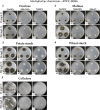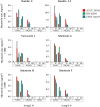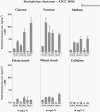A Chemically Defined Medium That Supports Mycotoxin Production by Stachybotrys chartarum Enabled Analysis of the Impact of Nitrogen and Carbon Sources on the Biosynthesis of Macrocyclic Trichothecenes and Stachybotrylactam
- PMID: 37338364
- PMCID: PMC10370337
- DOI: 10.1128/aem.00163-23
A Chemically Defined Medium That Supports Mycotoxin Production by Stachybotrys chartarum Enabled Analysis of the Impact of Nitrogen and Carbon Sources on the Biosynthesis of Macrocyclic Trichothecenes and Stachybotrylactam
Abstract
Stachybotrys chartarum (Hypocreales, Ascomycota) is a toxigenic fungus that is frequently isolated from water-damaged buildings or improperly stored feed. The secondary metabolites formed by this mold have been associated with health problems in humans and animals. Several authors have studied the influence of environmental conditions on the production of mycotoxins, but these studies focused on undefined or complex substrates, such as building materials and media that impeded investigations of the influence of specific nutrients. In this study, a chemically defined cultivation medium was used to investigate the impact of several nitrogen and carbon sources on growth of S. chartarum and its production of macrocyclic trichothecenes (MTs) and stachybotrylactam (STLAC). Increasing concentrations of sodium nitrate were found to positively affect mycelial growth, the level of sporulation, and MT production, while ammonium nitrate and ammonium chloride had an inhibitory effect. Potato starch was the superior and most reliable carbon source tested. Additionally, we observed that the level of sporulation was correlated with the production of MTs but not with that of STLAC. In this study, we provide a chemically well-defined cultivation medium suitable for standardized in vitro testing of the capacity of S. chartarum isolates to produce macrocyclic trichothecenes. IMPORTANCE Macrocyclic trichothecenes (MTs) are highly toxic secondary metabolites that are produced by certain Stachybotrys chartarum strains, which consequently pose a risk for animals and humans. To identify hazardous, toxin-producing strains by analytical means, it is important to grow them under conditions that support MT production. Nutrients determine growth and development and thus the synthesis of secondary metabolites. Complex rich media are commonly used for diagnostics, but batch differences of supplements pose a risk for inconsistent data. We have established a chemically defined medium for S. chartarum and used it to analyze the impact of nitrogen and carbon sources. A key finding is that nitrate stimulates MT production, whereas ammonium suppresses it. Defining nutrients that support MT production will enable a more reliable identification of hazardous S. chartarum isolates. The new medium will also be instrumental in analyzing the biosynthetic pathways and regulatory mechanisms that control mycotoxin production in S. chartarum.
Keywords: LC-MS/MS; Stachybotrys; carbon source; macrocyclic trichothecenes; nitrogen source; nutrients; stachybotrylactam.
Conflict of interest statement
The authors declare no conflict of interest.
Figures










References
-
- Andersen B, Nielsen KF, Jarvis BB. 2002. Characterization of Stachybotrys from water-damaged buildings based on morphology, growth, and metabolite production. Mycologia 94:392–403. - PubMed
-
- El-Kady IA, Moubasher MH. 1982. Toxigenicity and toxins of Stachybotrys isolates from wheat straw samples in Egypt. Exp Mycol 6:25–30. doi:10.1016/0147-5975(82)90060-3. - DOI
Publication types
MeSH terms
Substances
Supplementary concepts
LinkOut - more resources
Full Text Sources

